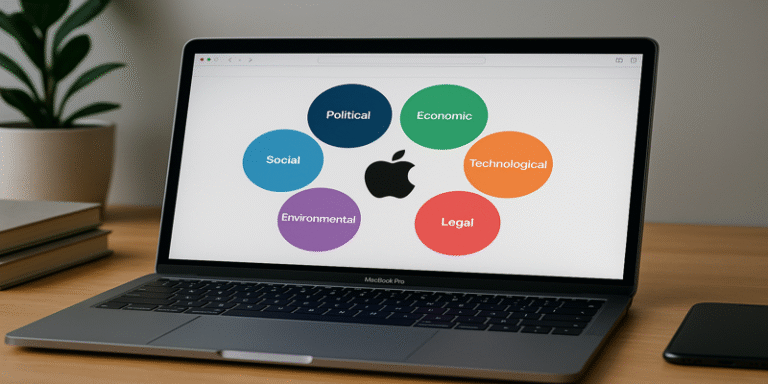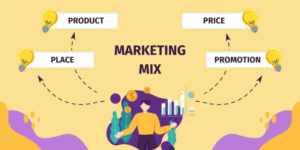This comprehensive PESTEL Analysis of Apple Inc. draws from academic sources, industry reports, and credible references using the Harvard Referencing System. It examines Political, Economic, Social, Technological, Environmental, and Legal factors shaping Apple’s macro environment and strategic direction.
As a global technology leader, Apple operates within a complex landscape influenced by geopolitical tensions, economic cycles, and shifting consumer expectations. The PESTEL framework enables a systematic evaluation of how these external forces affect Apple’s operations, innovation strategy, and competitive resilience.
Through this analysis, Apple’s ability to leverage brand strength, technological innovation, and sustainability initiatives while managing regulatory, ethical, and environmental challenges is explored to understand how it sustains long-term leadership in the global market.
1.0 Political Factors
Apple’s operations are significantly shaped by global political dynamics. The company faces regulatory scrutiny in multiple countries due to its market dominance, tax practices, and data governance.
For instance, the European Commission fined Apple for alleged anti-competitive practices (European Commission, 2020). The trade tensions between the United States and China have also affected Apple’s supply chain and increased tariffs on Chinese imports, including key iPhone components (Morrison, 2025). As Apple relies on outsourced manufacturing through partners like Foxconn in China, its exposure to geopolitical risk is high.
Moreover, political instability in sourcing countries for rare-earth metals (essential for iPhones and MacBooks) raises supply chain vulnerability (Chohan, 2020).
2.0 Economic Factors
Apple’s financial performance is intricately tied to macroeconomic trends, including inflation, interest rates, and exchange rate volatility. During the COVID-19 pandemic, Apple’s sales were impacted by reduced consumer spending and supply disruptions. However, the firm demonstrated resilience through digital services like Apple Music and iCloud.
With inflationary pressures affecting global purchasing power, premium-priced Apple products may face elastic demand in emerging markets (Khan, Alam and Alam, 2022). Additionally, the strengthening of the US dollar reduces Apple’s international earnings when converted back to USD (Apple Inc., 2023).
Apple’s strategy to increase revenue from services (which now exceeds 20% of total revenue) helps mitigate economic cyclicality (Morrison, 2025).
3.0 Social Factors
Social and cultural trends heavily influence Apple’s innovation and branding. The growing preference for premium, design-centric devices among Millennials and Gen Z aligns with Apple’s brand positioning. Moreover, digital lifestyles have accelerated demand for ecosystem integration — e.g., the seamless experience between iPhone, Apple Watch, and Mac.
Data privacy awareness is a significant concern. Apple has positioned itself as a privacy-first brand, implementing features such as App Tracking Transparency, winning public support but drawing criticism from advertisers (Chen, 2021).
Additionally, health and wellness trends have boosted Apple Watch sales due to its health-monitoring features, including ECG and blood oxygen tracking (Liu and Bae, 2022).
4.0 Technological Factors
As a technology leader, Apple invests over $27 billion annually in R&D (Apple Inc., 2023). Its strength lies in hardware-software integration, from the iOS operating system to proprietary chipsets like the M1 and M2 silicon.
Apple’s transition from Intel chips to its own Apple Silicon showcases its drive for performance optimisation and cost control. This also allows for tighter integration across devices, enhancing customer experience and brand loyalty (Chapple, 2021).
The company is exploring AR/VR (Apple Vision Pro) and AI technologies, competing with firms like Meta and Google. However, it lags behind in generative AI integration, creating a strategic challenge (Morrison, 2025).
Cybersecurity threats, digital rights management, and platform security remain key areas requiring technological leadership to maintain user trust.
5.0 Environmental Factors
Sustainability is becoming a competitive differentiator. Apple has committed to becoming carbon neutral by 2030 across its entire supply chain and product lifecycle (Apple Inc., 2023). It already uses 100% renewable energy in its corporate offices and data centres.
The company’s focus on recyclable materials — such as aluminium enclosures and rare-earth recovery — supports the circular economy movement (Geissdoerfer et al., 2017). Its Daisy robot, which disassembles iPhones for component recovery, is a leading example of green innovation.
Despite efforts, environmental activists question Apple’s product repairability and planned obsolescence, advocating for the Right to Repair (Monroe, 2021).
6.0 Legal Factors
Apple faces intense legal scrutiny globally. The most notable include:
- Epic Games v. Apple: Raised concerns over App Store monopoly and commission structures (Allyn, 2021).
- Anti-trust lawsuits in the EU and US regarding Apple’s dominance in digital services (Morrison, 2025).
- Compliance with GDPR and California Consumer Privacy Act (CCPA) adds complexity to data management strategies.
Further, Apple must navigate patent litigation, especially in highly competitive areas like semiconductors, health technology, and software interfaces.
The firm’s strict intellectual property enforcement also creates friction in global markets with differing IP laws, such as China and India (Shah and Dave, 2020).
Apple Inc.’s performance is deeply entwined with its macro-environment, as illustrated by the PESTEL framework. While the firm benefits from technological innovation, strong brand equity, and financial muscle, it remains exposed to regulatory, economic, and geopolitical risks.
To thrive, Apple must:
- Strategically diversify its supply chain beyond China,
- Further invest in sustainability and circularity, and
- Maintain trust by evolving its privacy and AI governance frameworks.
References
Apple Inc. (2023) Annual Report 2023. [Online] Available at: https://investor.apple.com
Allyn, B. (2021) ‘Judge rules Apple must allow other forms of in-app purchases in Epic lawsuit’, NPR. [Online] Available at: https://www.npr.org
Chen, Y. (2021) ‘Apple’s privacy changes reshape the digital advertising industry’, Harvard Business Review, 99(4), pp. 15–18.
Chohan, U.W. (2020) ‘Rare Earth Elements: Supply Risks, Alternatives and Trade Policy’, Energy Policy Journal, 140, 111428.
Chapple, M. (2021) ‘Apple Silicon: The M1 Revolution’, Computer Weekly, [Online] Available at: https://www.computerweekly.com
European Commission. (2020) Antitrust: Commission sends Statement of Objections to Apple on App Store rules. [Online] Available at: https://ec.europa.eu
Geissdoerfer, M. et al. (2017) ‘The Circular Economy – A new sustainability paradigm?’, Journal of Cleaner Production, 143, pp. 757–768.
Khan, M., Alam, R. and Alam, M. (2022) ‘Macroeconomic Determinants of Consumer Electronics Demand in Emerging Markets’, Journal of Economic Perspectives, 36(2), pp. 45–61.
Liu, H. and Bae, S. (2022) ‘Wearable Tech and the Healthcare Consumer: Case of Apple Watch’, Technology in Society, 68, 101924.
Monroe, J. (2021) ‘Apple and Right to Repair: Balancing Innovation with Consumer Rights’, The Guardian. [Online] Available at: https://www.theguardian.com
Morrison, M. (2025) Strategic Vulnerability and Competitive Positioning of Apple Inc.: A PESTEL and Porter’s Five Forces Analysis. SSRN. [Online] Available at: https://papers.ssrn.com/sol3/papers.cfm?abstract_id=5315266
Shah, N. and Dave, R. (2020) ‘Intellectual Property Rights Disputes in the Tech Industry: A Global Analysis’, Global Business Review, 21(5), pp. 1172–1190.









